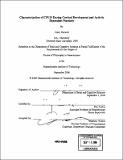| dc.contributor.advisor | Elly Nedivi. | en_US |
| dc.contributor.author | Harwell, Corey (Corey C.) | en_US |
| dc.contributor.other | Massachusetts Institute of Technology. Dept. of Brain and Cognitive Sciences. | en_US |
| dc.date.accessioned | 2007-07-18T13:17:04Z | |
| dc.date.available | 2007-07-18T13:17:04Z | |
| dc.date.copyright | 2006 | en_US |
| dc.date.issued | 2006 | en_US |
| dc.identifier.uri | http://hdl.handle.net/1721.1/37964 | |
| dc.description | Thesis (Ph. D.)--Massachusetts Institute of Technology, Dept. of Brain and Cognitive Sciences, 2006. | en_US |
| dc.description | Includes bibliographical references (p. 88-101). | en_US |
| dc.description.abstract | Regulation of gene transcription by neuronal activity is thought to be key to the translation of sensory experience into long-term changes in synaptic structure and function. Here we show that cgp15, a gene encoding an extracellular signaling molecule that promotes dendritic and axonal growth and synaptic maturation, is regulated in the somatosensory cortex by sensory experience capable of inducing cortical plasticity. Using in situ hybridization, we monitored cgp15 expression in 4-week-old mouse barrel cortex after trimming all whiskers except D1. We found that cpgl5 expression is depressed in the deprived barrels and enhanced in the barrel column corresponding to the spared D1 whisker. Induction of cpgl5 expression is significantly diminished in adolescent as well as adult CREB knockout mice. cgp15 spatio-temporal expression pattern and its regulation by CREB are consistent with a role in experience-dependent plasticity of cortical circuits. Our results suggest that local structural and/or synaptic changes may be a mechanism by which the adult cortex can adapt to peripheral manipulations. The balance between proliferation and apoptosis is critical for proper development of the nervous system. | en_US |
| dc.description.abstract | (cont.) Yet, little is known about molecules that regulate apoptosis of proliferative neurons. Here we identify a soluble, secreted form of CPG15 expressed in embryonic rat brain regions undergoing rapid proliferation and apoptosis, and show that it protects cultured cortical neurons from apoptosis by preventing activation of caspase 3. Using a lentivirus-delivered small hairpin RNA, we demonstrate that endogenous CPG15 is essential for the survival of undifferentiated cortical progenitors in vitro and in vivo. We further show that CPG15 overexpression in vivo expands the progenitor pool by preventing apoptosis, resulting in an enlarged, indented cortical plate and cellular heterotopias within the ventricular zone, similar to the phenotypes of mutant mice with supernumerary forebrain progenitors. CPG15 expressed during mammalian forebrain morphogenesis may help balance neuronal number by countering apoptosis in specific neuroblasts subpopulations, thus influencing final brain size and shape. | en_US |
| dc.description.statementofresponsibility | by Corey Harwell. | en_US |
| dc.format.extent | 102 p. | en_US |
| dc.language.iso | eng | en_US |
| dc.publisher | Massachusetts Institute of Technology | en_US |
| dc.rights | M.I.T. theses are protected by copyright. They may be viewed from this source for any purpose, but reproduction or distribution in any format is prohibited without written permission. See provided URL for inquiries about permission. | en_US |
| dc.rights.uri | http://dspace.mit.edu/handle/1721.1/7582 | |
| dc.subject | Brain and Cognitive Sciences. | en_US |
| dc.title | Characterization of CPG15 during cortical development and activity dependent plasticity | en_US |
| dc.type | Thesis | en_US |
| dc.description.degree | Ph.D. | en_US |
| dc.contributor.department | Massachusetts Institute of Technology. Department of Brain and Cognitive Sciences | |
| dc.identifier.oclc | 144609184 | en_US |
